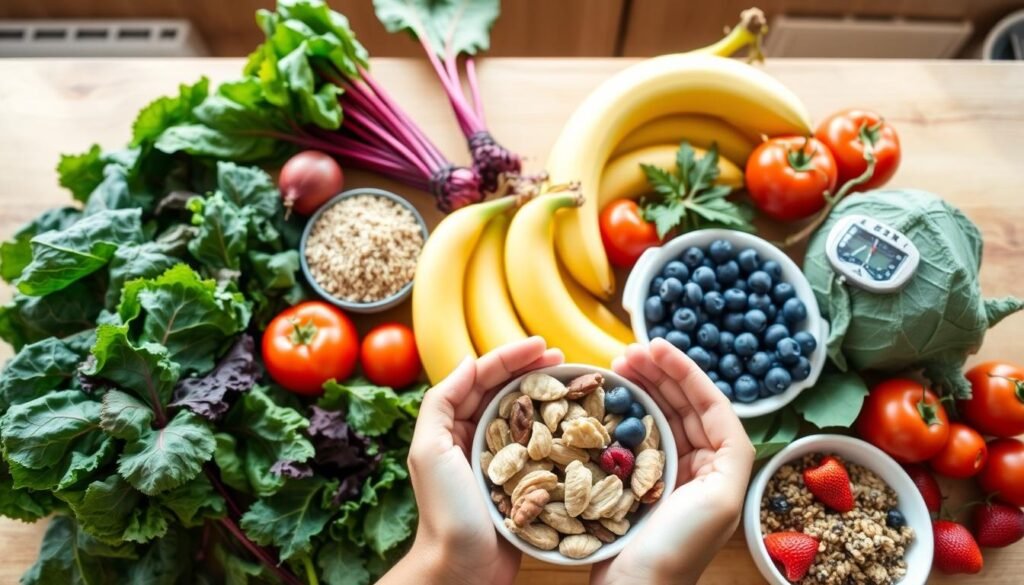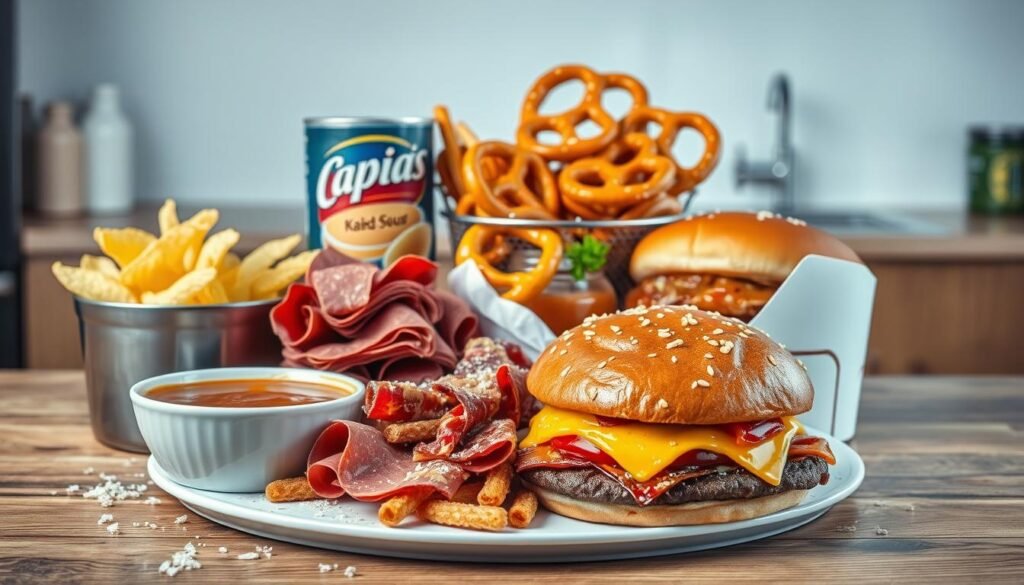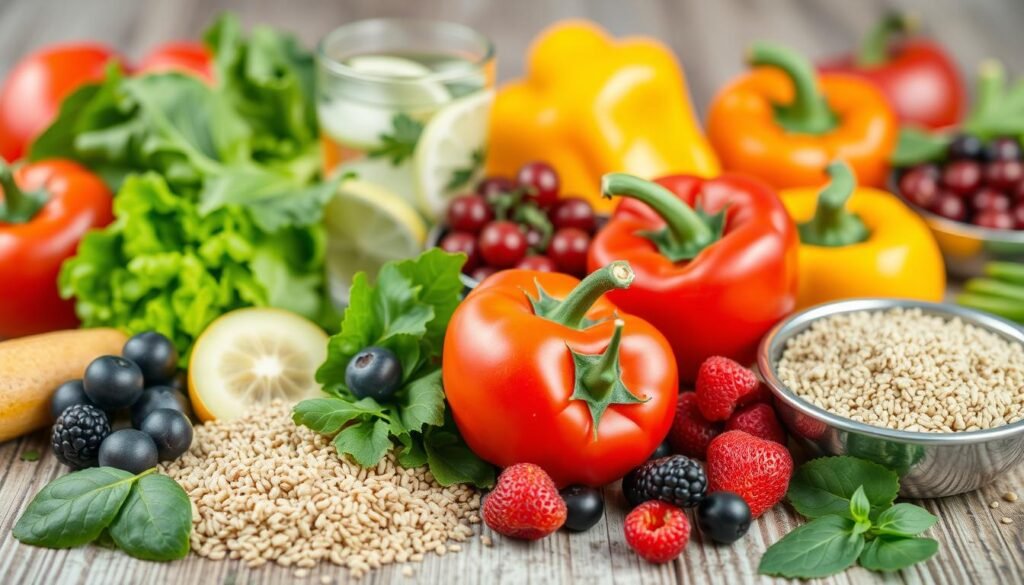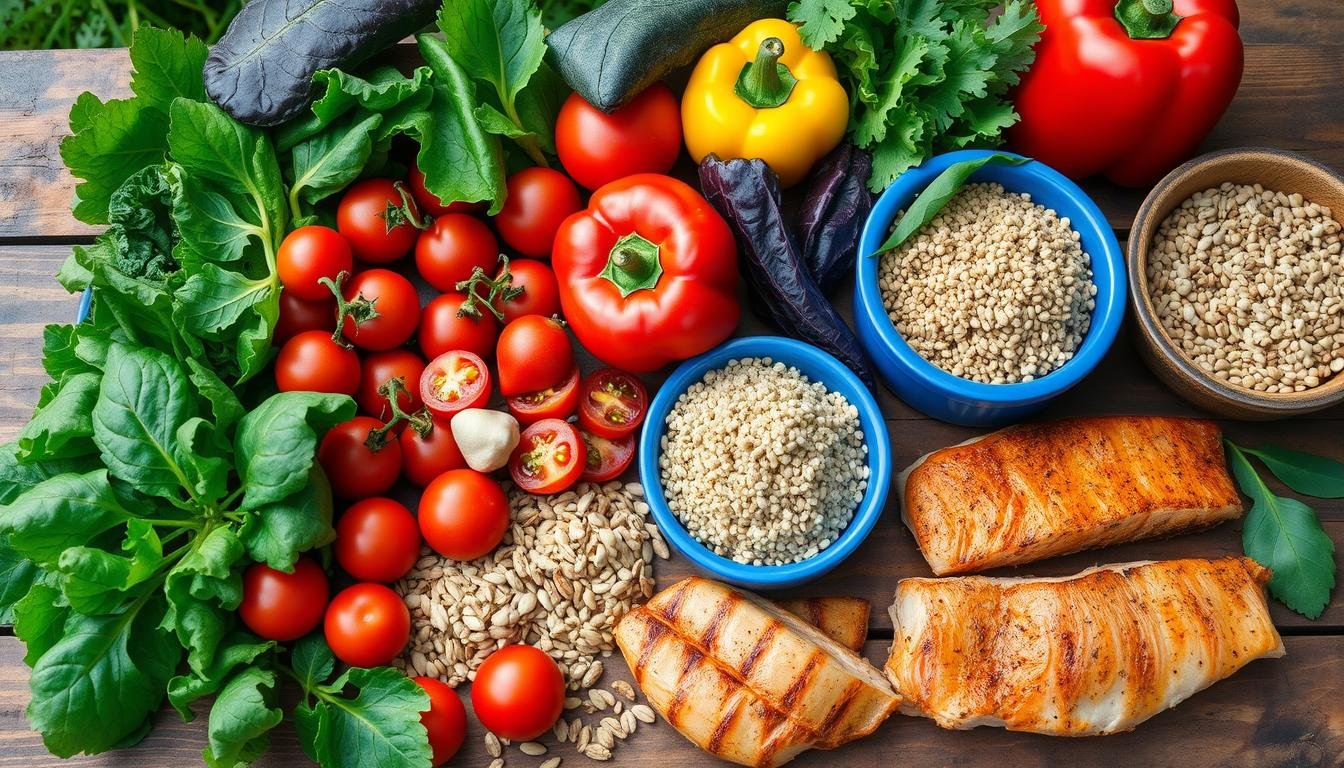Hypertension, or high blood pressure, is a big risk for heart disease and stroke. Keeping blood pressure healthy is key for heart health. The good news is that diet and lifestyle changes can help manage high blood pressure and lower disease risk.
The Dietary Approaches to Stop Hypertension (DASH) diet is a proven plan to fight high blood pressure. It focuses on eating lots of fruits, veggies, whole grains, lean proteins, and low-fat dairy. It also limits foods high in sodium, added sugars, and saturated fats.
Key Takeaways
- Hypertension is a major risk factor for heart disease and stroke.
- The DASH diet emphasizes fruits, vegetables, whole grains, lean proteins, and low-fat dairy to manage high blood pressure.
- Limiting sodium intake, especially from processed foods and restaurant meals, is crucial for maintaining healthy blood pressure levels.
- Incorporating a variety of nutrient-dense foods, such as berries, nuts, and legumes, can help lower blood pressure.
- Maintaining a healthy lifestyle, including regular physical activity and stress management, can also contribute to better blood pressure control.
Also Read : Diabetes Prevention: How To Lower Your Risk Of Developing Diabetes
Understanding the Link Between Diet and Blood Pressure
Keeping blood pressure healthy is key for good health, and diet is a big part of it. High blood pressure, or hypertension, can come from too much salt, drinking too much alcohol, and not moving enough. Knowing how diet affects blood pressure helps people manage their health and avoid serious problems.
Also Read : Cancer Treatment Options: From Surgery To Immunotherapy
What Causes High Blood Pressure?
High blood pressure is divided into two types: essential and secondary. Essential hypertension is the most common and is often due to lifestyle choices like diet and exercise. Secondary hypertension is caused by other health issues, medicines, or certain factors.
The Role of Diet in Blood Pressure Management
The American Heart Association suggests eating foods like fruits, veggies, whole grains, and lean proteins. It’s also good to cut down on fats, alcohol, sodium, and sugary foods. The DASH diet is a plan that focuses on these foods and limits others to help control blood pressure.
The Impact of Lifestyle on Blood Pressure Levels
Lifestyle choices are just as important as diet for blood pressure. Being active, managing weight, and reducing stress can help keep blood pressure in check. Quitting smoking and drinking less alcohol are also key lifestyle changes for better blood pressure.
Also Read : The Art Of Home Cooking: Elevating Everyday Dishes
“Eating a diet rich in fruits, vegetables, whole grains, and lean proteins can help lower blood pressure and reduce the risk of heart disease.”
Understanding the link between diet, lifestyle, and blood pressure helps people improve their heart health. It also lowers the chance of getting hypertension and its complications.
Also Read : Urban Wildlife Conservation: Protecting Nature In Growing Cities
Essential Foods That Help Lower Blood Pressure

Keeping your blood pressure healthy is key for your overall well-being. Certain foods can help a lot in this area. Adding these nutrient-rich foods to your diet can make a big difference.
Focusing on fruits and vegetables with nitrates and potassium is a smart move. Beetroot, spinach, celery, kale, bananas, and strawberries are great choices. They can relax blood vessels and help control systolic pressure and diastolic pressure.
Also Read : The Role Of Animal Nutrition In Enhancing Immune System Function
- Beetroot is full of nitrates, which can widen blood vessels and lower blood pressure.
- Leafy greens like spinach and kale are rich in potassium, important for healthy blood pressure.
- Bananas and other fruits high in potassium can help balance out sodium’s effects.
Whole grains, lean proteins, and low-fat dairy are also good for blood pressure. They offer important nutrients and fiber for heart health.
“Eating a variety of colorful fruits and vegetables gives you lots of nutrients for healthy blood pressure.”
Choosing the right foods can help keep your blood pressure in check. This proactive approach can reduce the risk of heart problems.
Hypertension: Foods and Substances to Avoid

Keeping your blood pressure healthy is key for your heart. Some foods can help lower excessive pressure. But, others can make blood pressure too high, raising the risk of systemic hypertension and cardiovascular disease.
High-Sodium Foods and Hidden Salt Sources
Too much sodium can raise your blood pressure. Processed and fast foods are often high in sodium. Foods like burgers, pizza, and cold cuts have too much salt.
Caffeine and Alcohol Considerations
Drinking too much caffeine can also raise blood pressure. Drinking two or more cups of caffeinated coffee can be risky. Too much alcohol can also increase blood pressure. The American Heart Association suggests drinking no more than two drinks a day for men and one for women.
Processed and High-Fat Foods
Processed and high-fat foods can also lead to high blood pressure. Foods high in fructose can increase salt absorption. Red meat, especially processed red meat, can also raise blood pressure. It’s best to limit saturated fats to 5–6% of your daily calories.
By choosing healthier foods, you can help manage your blood pressure. This can also lower your risk of cardiovascular disease.
Practical Diet Strategies for Blood Pressure Management

Keeping your blood pressure healthy is key to your well-being. By choosing the right foods, you can manage your blood pressure well. Here are some useful diet tips:
- Try the DASH Diet: The Dietary Approaches to Stop Hypertension (DASH) diet focuses on foods that lower blood pressure. These include fruits, vegetables, whole grains, and lean proteins.
- Watch Your Sodium: Eating less than 2,300 mg of sodium a day helps lower blood pressure. If you have high blood pressure, aim for 1,500 mg.
- Eat More Potassium: Aim for 3,500 to 5,000 mg of potassium daily. Include more fruits, vegetables, and low-fat dairy in your diet. Potassium can lower blood pressure by 4 to 5 mm Hg.
- Choose Lean Proteins: Pick lean meats, poultry, fish, legumes, and low-fat dairy for your protein. This helps manage your blood pressure.
- Focus on Whole Grains: Whole grains like whole wheat bread, brown rice, and oats increase potassium. They help lower blood pressure.
Other lifestyle changes also help manage blood pressure. Regular exercise, a healthy weight, stress management, and enough sleep are important. A good treatment plan might include diet changes, lifestyle adjustments, and sometimes medication.
By using these diet tips and a holistic approach to managing blood pressure, you can improve your health. Work towards your blood pressure goals.
Also Read : Mondor’s Disease: Symptoms, Causes & Treatment
Conclusion
Managing high blood pressure starts with a healthy diet. The DASH diet is a good choice. It focuses on fruits, veggies, whole grains, and lean proteins. It also limits salt, sugar, and fats.
Adding regular exercise and managing stress are also key. Working with your doctor is important. They can help you create a plan that might include diet changes and medicine.
By choosing the right foods and making lifestyle changes, we can fight high blood pressure. This approach includes eating well, exercising, and managing stress. It’s a powerful way to protect our hearts.
Keeping blood pressure in check is vital for our health. It helps prevent heart disease. By following diet guidelines and making lifestyle changes, we can control our blood pressure. This leads to a healthier life ahead.
FAQs
Source Links
- https://www.heart.org/en/health-topics/high-blood-pressure/changes-you-can-make-to-manage-high-blood-pressure/shaking-the-salt-habit-to-lower-high-blood-pressure
- https://www.healthline.com/nutrition/foods-high-blood-pressure
- https://www.heart.org/en/health-topics/high-blood-pressure/changes-you-can-make-to-manage-high-blood-pressure/managing-blood-pressure-with-a-heart-healthy-diet





